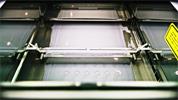New Renishaw technology cuts additive manufacturing build times by up to 50%
7th November 2023
Global engineering technologies company Renishaw has launched TEMPUS™ technology, which enables users of its additive manufacturing (AM) systems to achieve significantly higher productivity, with no reduction in part quality. The time and cost savings achieved through TEMPUS technology will further the use of AM as a volume production method and help drive wider adoption.
Unveiled at Formnext 2023, TEMPUS incorporates a new scanning algorithm for Renishaw's RenAM 500 series of metal AM systems, which allows the laser to fire while the recoater is moving, saving up to nine seconds per build layer. Over the cycle time of the build, the time saving can cut the build time by up to 50%. Crucially, there is no reduction in part quality.
With TEMPUS technology, as the recoater spreads a layer of powder, the lasers “follow” the recoater, melting the powder being spread before the recoater completes its stroke. When the recoater goes back to the doser to collect more powder, the lasers “jump over” the recoater and continue melting the current layer, mitigating wiper time. As the recoater begins spreading the next layer of powder, the lasers finish the previous layer, and simultaneously starts processing the new layer. TEMPUS technology reduces the dwell time per layer, shortening cycle times.
The technology works using advanced scanning algorithms that sequence the layer data in a way that maximises productivity while maintaining part quality. The optimisation suits some part geometries more than others, but all geometries can see some productivity benefits. Those parts with thin, vertical features, for example, are likely to experience higher productivity savings.
“Reducing cost per part is critical to the wider adoption AM technology,” explained Louise Callanan, Director of Additive Manufacturing at Renishaw. “The dominant contributing factor to part cost for most components today is the time spent building the part on the machine itself. Reducing the amount of machine time per part therefore results in more cost-effective production.”
“That's why TEMPUS technology is such a big leap forward,” added Callanan. “Usually, the laser would turn off while the recoater is moving. Firing the laser while the recoater is moving minimises the laser off-time per build. The time and cost saving TEMPUS brings will open AM up to mass production applications where the technology would previously have been unviable.”
TEMPUS technology is standard fitment with new RenAM 500 Ultra metal AM systems, which are available with quad or single laser configuration. Existing RenAM 500 series customers can access TEMPUS as a paid-for upgrade. Renishaw data shows that retrofitting TEMPUS technology to an existing system is the equivalent of adding an extra laser, and allows existing customers to make the most of their machine investment.
For uses in consumer electronics and computing, Renishaw has entered into an exclusive partnership agreement with metal component expert Alloyed, which has been using TEMPUS technology since 2021.
Renishaw offers a suite of additive manufacturing technologies to help customers develop a high quality, productive end-to-end solution, and has launched software, hardware and processes that enhance the additive manufacturing process chain. Recent launches include Optical System Verification (OSV), a three-stage in-house laser testing and calibration process that enables users to quickly confirm machine performance.
For further information on Renishaw's additive manufacturing systems, visit www.renishaw.com/am
Downloads
- News release: New Renishaw technology cuts additive manufacturing build times by up to 50% [106kB]
-
 3D printing with TEMPUS technology
[3840 x 2160]
[14.8MB]
3D printing with TEMPUS technology
[3840 x 2160]
[14.8MB]
For further images, videos, company biographies or information on Renishaw and its products, visit our Media Hub.
